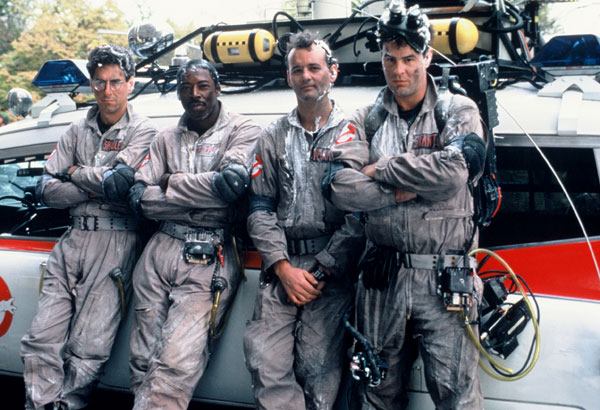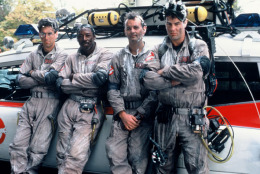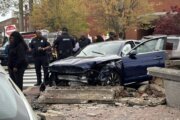
Columbia Pictures just held "National Ghostbusters Day" in honor of the 30th anniversary of "Ghostbusters" (1984).
Today, a remastered restoration hits movie theaters nationwide and runs all Labor Day weekend.
The new, restored version arrives on Blu-Ray Sept. 16.
Here's a look back at the film's legacy and some fun facts you may not have known about the movie.
For this trivia, who ya gonna call? WTOP Film Critic Jason Fraley.
After the success of "The Blues Brothers," Dan Aykroyd wrote an original screenplay called "Ghost Smashers," where he and John Belushi traveled through space and time, hunting ghosts.
Director Ivan Reitman ("Stripes") called the original draft "the phone book" because it was so thick and suggested moving the setting to present-day New York City.
Reitman hired his "Animal House" writer Harold Ramis to help Aykroyd rewrite the script into the version we know today. Many of the film's lines were ad-libbed, with Bill Murray cleverly quipping about a falling bookcase: "Has this ever happened to you before?"
Aykroyd's original concept was shattered when John Belushi died of a cocaine and heroin overdose in 1982. During the making of "Ghostbusters," Aykroyd referred to the "Slimer" apparition as the ghost of John Belushi.
With Belushi gone, Aykroyd needed a co-star. Chevy Chase was offered the role of Dr. Peter Venkman, but turned down it down because the original script was too dark. Instead, the role went to Chase's "Caddyshack" co-star Bill Murray, who agreed to do "Ghostbusters" if Columbia cast him in the remake of "The Razor's Edge" (1946).
As for the third Ghost Buster, Harold Ramis had no intention of starring in the film; he was simply the screenwriter. Christopher Walken, John Lithgow, Christopher Lloyd and Jeff Goldblum were all considered for the role of Dr. Egon Spengler, before Ramis stepped in to play it himself. He went on to write and direct Bill Murray in "Groundhog Day" (1993).
The role of Winston was originally written for Eddie Murphy, who chose to appear in "Beverly Hills Cop" instead. As a result, the role was trimmed down and given to Ernie Hudson.
John Candy was originally tapped to play Louis Tully, but he quit because his ideas were being rejected. The role went to Candy's "Spaceballs" co-star Rick Moranis, who gets locked out of various doors before becoming the "Keymaster."
As for the "Gatekeeper," the role of Dana/Zuul was turned down by punk rocker Anne Carlisle before going to "Alien" star Sigourney Weaver. Her demonic voice was performed by director Ivan Reitman.
"Ghostbusters" thrives off apocalyptic themes of biblical proportions. Dan Aykroyd warns of "fire and brimstone," Harold Ramis warns of "earthquakes and volcanos" and Bill Murray sarcastically screams, "Dogs and cats living together! Mass hysteria!"
Indeed, the movie walks the tightrope between mocking and embracing religion, as a priest tells the mayor, "I believe it's an act of God, but don't quote me." Soon after, Murray shouts at Stay Puft, "No one stomps a church on my watch!"
Likewise, it's a religious discussion that provides the film's most eerie shot. As Aykroyd and Hudson discuss "dead rising from the grave" on Judgment Day, the camera pulls back for a skyline view of the Twin Towers.
"Ghostbusters" featured a number of celebrity cameos.
The film marked the film debut of news anchor Larry King.
Adult film star Ron Jeremy appears as an extra looking up at the skyscrapers during the climax. He later starred in the porn parody "This Ain't Ghostbusters XXX."
Most impressively, you'll notice the late Casey Kasem giving a "Ghost Busters" shoutout on "American Top 40."
The film earned a second Oscar nomination for visual effects. Many of the effects were achieved by practical solutions, with prop workers hiding behind library shelves and pushing out the drawers from behind. In the floating Sigourney Weaver scene, the actress was placed in a full body cast and attached to a post.
After shooting a month in Manhattan, the cast and crew returned to a Burbank Studios soundstage to shoot the rooftop temple scene, which included a 360-degree panorama of New York City. A second soundstage was used for Dana's apartment and the hotel.
The film's final destruction was achieved by an actor in a Stay Puft Marshmallow Man suit stomping on miniatures (a la "Godzilla"). Three suits were used, costing $20,000 apiece, and all three were destroyed during filming.
"Ghostbusters" features one of the most famous logos of any movie.
Dan Aykroyd came up with the concept and brought the idea to former "National Lampoon" art director Michael Gross, who flipped the direction of the European "no" sign over a cartoon ghost.
Gross says it was one of the very first American uses of the "no" signal.
"Ghostbusters" remains the highest grossing "horror comedy" of all time with $238 million, far ahead of the runner-ups "Scary Movie" ($157 million) and "Gremlins" ($153 million).
The movie trounces other classics of the genre, including "An American Werewolf in London" ($30 million), "Shaun of the Dead" ($13 million) and "Evil Dead 2" ($5 million).
"Ghostbusters" was such a hit that it inspired the animated TV series "The Real Ghost Busters," which ran from 1986 to 1991.
A feature film sequel followed with "Ghostbusters II" (1989). It was a hit at the box office at $112 million, the seventh-highest grossing film of the year. It did not, however, fare well among critics, garnering a 51% on Rotten Tomatoes compared to 97% for the original.
Another sequel, "Ghostbusters III," is reportedly in the works.








